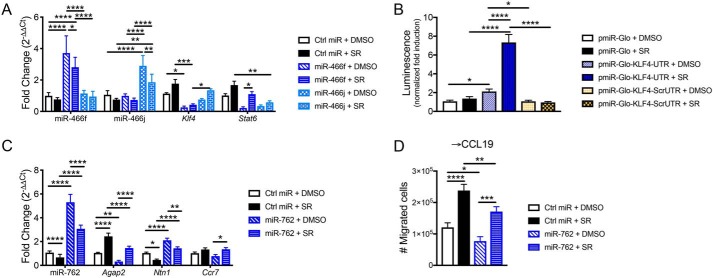Figure 7.
Overexpression of miR-466f, miR-466j, and miR-762 reverses effects of SR141716A treatment in macrophages. Thioglycollate-elicited peritoneal macrophages were harvested from naïve mice; then transfected with a scrambled negative control miR oligonucleotide (Ctrl miR) or miR-466f, miR-466j, or miR-762 mimic; and then cultured for 24 h in conditioned medium from 3T3-L1 adipocytes + 10 μm SR or DMSO vehicle. A, qRT-PCR of miR-466f, miR-466j, Klf4, and Stat6 in macrophages transfected with miR-466f or miR-466j ± SR. For B, luciferase reporter assay was performed in RAW264.7 macrophages transfected with pmirGLO, pmirGLO-KLF4-UTR, or pmirGLO-KLF4-ScrUTR and then incubated for 24 h with SR141716A (10 μm) or DMSO vehicle. B, firefly luciferase activity was measured by luminescence and normalized to pmirGLO + DMSO negative control. For C and D, 5 × 105 peritoneal macrophages were plated in FluoroBlok inserts and then transfected with miR oligonucleotides and cultured for 24 h in conditioned medium from 3T3-L1 adipocytes + 10 μm SR or DMSO vehicle. At 12 h of culture, medium containing 500 ng/ml CCL19 was added to the bottom well, and migrated cells were harvested at 24 h for migration analysis and qRT-PCR. C, qRT-PCR of miR-762, Agap2, Ntn1, and Ccr7 in macrophages transfected with miR-762 ± SR. D, number of cells migrated toward CCL19. Data are mean ± S.D. (error bars). ****, p < 0.0001; ***, p < 0.001; **, p < 0.01; *, p < 0.05 by one-way ANOVA.

